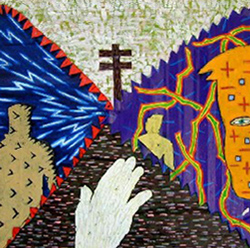Good Times & Progress
By Jeff Rubin, NEW ORLEANS ART REVIEW

"Grapevines"
LOUISIANA’S PENCHANT FOR easy money and good times trickles down to the melodrama of its citizenry in Francis Pavy’s metal cutout images at Arthur Roger Gallery. These paintings deftly illustrate the ever-increasing urban- and suburbanization of Acadiana. As the rural landscape gives way to increasing commerce and development, the good and the bad become fused/confused within the lifestyle of its people, providing proof and subject matter for Pavy’s compositions. Images of gambling, guitars, liquor, telephone poles, human figures, and urban buildings recur throughout, each usually occupying a portion of these highly segmented compositions.
All of the paintings here are assembled from pieces of thin sheet metal that are layered across the surface, onto which Mr. Pavy paints. Each piece of metal usually contains a discreet segment of the image, forming arrangements that interlock and help move the eye across the painting. Although by no means subtle, the vignettes depicted in these images fuse the allure and mysteries of south Louisiana with the influence of legalized gambling, alcohol, mass communication, and the encroaching of development of the landscape. Mix this with a sure handling of color and the use of pattern and the results are images that are both engaging and thoughtful.
Mortality and the Eternal Party is a sort of morality play on the bayou, featuring Louisianian’s passion for over indulgence and liquor bottles, with an empty pirogue floating like a funeral barge across the water. Who would have thought that the people of south Louisiana would take to legalized gambling? The promise and perils of rolling the dice get illustrated in two works here. Good Luck and Bad Luck. Good luck would certainly be a gushing oil well and a pair of hot dice, and in Good Luck, they each share a portion of the concept. An outstretched hand with a ray of light emanating from a lucky pair of dice anchors the center of this image. Surrounding this are two gushing oil wells, a big green car and red female figure I wouldn’t know such luck. Contrast this with the pieces of Bad Luck. As in Good Luck, the center of the painting is a pair of dice showing craps. Two hands, each holding a wad of cash for the taking, are anchored in the bottom left and right. Throughout many of Mr. Pavy’s paintings, he incorporates a skyline of buildings, reminiscent of the type of anonymous apartment buildings found in New York City. Here, they flank the left and right side, with a purple colored male figure at center top. The figure and the buildings are in high contrast with a scumbled yellow background up top and a red and gold design below.
The telephone pole and its wires are an apt symbol for communication and the closing of distances. In Grapevines the telephone pole acts as an electrifying element to a simple composition. The image is roughly quartered into triangular areas with their edges rough and zigzagged. A figure and hand are present again, uniting with an area of bright marks and patterns to form a simple union to transport vital information and gossip. In many of the paintings, areas are delineated from each other by the zigzag edges of the metal sheets In Modern Travelers, the image is split diagonally, an airplane flying through gold stars in the upper region and an auto driving through a marsh of blue reeds in the lower region. Along the diagonal are three ovoid shapes with scenes painted within each. A marshy area contains a head, the middle scene features the recurring cityscape/buildings and the bottom space has a woman’s head and the utility/telephone poles.
It will be interesting to watch the continuing evolution of south Louisiana through Mr. Pavy’s paintings, As the world continues to diminish in size and as the means of progress feed on the unique, the confrontation between what will remain as singularly ours and what will become more like everything else will hopefully play out in Mr. Pavy’s work.
